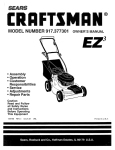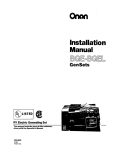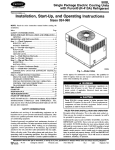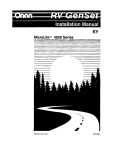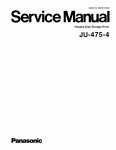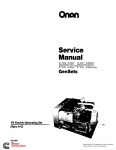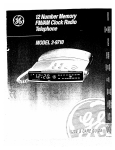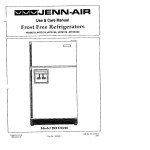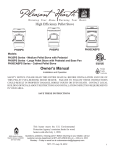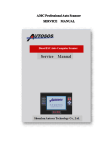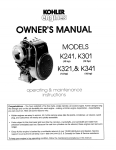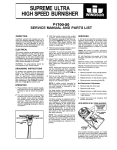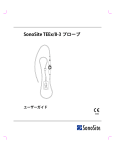Download Operator`s Manual
Transcript
Operator’s Manual Model BGD and NHD Generator Sets Printed in U.S.A. 965-0129 4-93 Safetv Precautions Before operating the generator set, read the Operator’s Manual and become familiar with it and the ui ment. Safo and efficient opwatlon can be achieved on y the unit is properly operated and maintained. Many accidents are caused by failure to follow fundamental rules and precautions. The following symbols, found throughout this manual, alert you to potentiall dangerous conditionstothe operator, servicepersonnel, or e equipment. ”IR tx This symbol warns o f immediate hazards which will result in severe personai injuty or death. @VZU”G This symbol refersto a hazard or unsafe practice wbich can result in severe personal Injuiy or death. hi CAUTIOi Thissymbol refersto a hazard or unsafe ---.practice which can resuit in personal injuv or product or property damage. FUEL AND FUMES ARE FLAMMABLE. Fire, explosion. and personal injury can result from improper practices. DO NOTfill fuel tanks while engine is running. Fuel contact with hot engine or exhaust is a potential fire hazard. DO NOT SMOKE OR USEAN OPEN FLAMEnear the generator set or fuel tank. Fuel lines must be adequately secured and free of leaks. Fuel connection at the engine should be made with an a p provedflexiMe, norrconductiveline. Do not use copper p i p n g on flexible lines as copper will work hardenand become brittle. Be sure all fuel supplies have a positive shutoff valve. GASOLINE AND LPG FUEL MAY BE ACCIDENTAUY IG N E D BY ELECTRICALSPARKS, resentlngtheharsrdof flre or explosion, which can resu t In severe personal Injury or death. When installlng the generator set: P Do not tie electrical wiring to fuel lines. Do not run electrical lines and fuel lines through the same compartmentopenings. Keep electrical and fuel lines as far apart as possible. Place a physical barrier between fuel lines and electrical lines wherever possible. H electrical and fuel lines must passthrough the same compartment opening, make certain that they are physically separated by running them through individual channels. or by passing each line through a separate piece of tubing. DO NOT SMOKE while servicing batteries. Lead acid batteries emit a highly explosive hydrogen gas that can be ignited by electrical arcing or by smoking. EXHAUST GASES ARE DEADLY 0 0 Never sleep inthe vehicle with the generator set running unless vehicle is equippedwith an operating carbon monoxide detector. Provide an adequate exhaust system to properly expel discharged gases. Inspect exhaust system daily for leaks per the maintenance schedule. Ensurethat exhaust manifolds are secure and not warped. Do not use exhaust gases to heat a compartment. Be sure the unit is wall ventilated. MOVING PARTS CAN CAUSE SEVERE PERSONAL JURY OR DEATH 0 IN- Beforestarting work onthe generator set, disconnect batteries. This will prevent accidental arcing. Keep your hands away from moving parts. Make sure that fasteners on the generator set are 3. Tighten supports and damps, keep guards in position over 4 fans, drive belts, etc. Do not wear loose clothing or jewelry while working on generator seis. Loose clothing and jewelry can become caught in moving parts. Jewelry can short out electrical contaqts and cause shock or burning. If adjustment must be made while the unit is running. use extreme caution around hot manifolds, moving parts. etc. ELECTRICAL SHOCK CAN CAUSE SEVERE PERSONAL INJURY OR DEATH Disconnect starting battery before removing protective shields or touching electrical equipment. Use rubber insulative mats placed on dry wood platforms over floors that are metalor concretewhen around electricalequipment. Donot weardampclothing (particularlywetshoes)orallowskinsurfaces to be damp when handling electrical equipment. Use extreme caution when working on electrical components. High voltages can cause injury or death. Followall state and localelectrical&des. Have all electrical installations performed by a qualified licensed electrician. Tag open switches to avoid accidental closure. DO NOT CONNECT GENERATOR SET DIRECTLY TO ANY BUILDING ELECTRICAL SYSTEM. Hatardous voltages canflow from the generatorset i n t o h utililine. This creates a potential for electrocution ar property I 3. Connect only through an approveddevice and aftei g main switch is open. Consult an eledriaan in rbyyIy ;o emergency power use. GENERAL SAFETY PRECAUTIONS Haveafire extinguishernearby. Maintainextinguisher prop erly and become familiar with its use. Extinguishers rated ABC by the NFPA are appropriate for all applications. Consult the local fire department for the correct type of extinguisher for various applications. Hot coolants under pressure can cause severe personal injury. DO NOTopena radiator pressurecap whilethe engine is running. Stop the engine and carefully bleed the system pressure. Benzeneand lead, fwnd in some gasoline, have been iden- tified by some state and federal agencies ascausing cancer or reproductivetoxici. When checking, draining or adding gasdine, take care not to ingest, breathe the fumes, or contact gasoline. Used engine oils have been identified by some state or federal agencies as causing cancer or reproductive toxicity. When checking or changing engine oil, take care not to ‘7gest, breathe the fumes, or contact used oil. Removeall unnecessarygrease andoil from the unit. Accumulated grease and oil can cause overheating and engiy damage, which presents a potential fire hazard. DO NOT store anything inthe generator mmparbn as oil or gas cam,oily rags, chains, wooden blocks, ; I 0 propane cylinders, etc. A fire could result or the g lr set operation (cooling, noise and vibration) may be adversely affected. Keep the compartmentfloor clean and dry. Do not work on this equipment when mentally or physically Redistribution publicationany of this document, fatigued, or afterorconsuming alcohol or drug that makes byofany means, isunsafe. strictly prohibited. the operation equipment RV-9 . . . . . . Table of Contents SECTION TITLE 1 2 3 4 PAGE ................................ ..................................................... ................................................. ................................................... ........................................................ .................................................... ............................................... .............................................. ................................................. ............................................... ............................................. .................................................... .......................................... ............................................. ..................................................... ................................................. ........................................................... ..................................................... ......................................................... ....................................................... ................................................... .......................................................... ......................................................... ....................................................... .......................... ......................................... SAFETY PRECAUTIONS Inside Front Cover INTRODUCTION 1-1 About This Manual 1-1 How to Obtain Service .............................................. 1-1 SPECIFICATIONS 2-1 OPERATION 3-1 3-1 Before Starting Recommended Fuels 3-2 3-2 Starting and Stopping 3-2 Break-in Procedure Operating Conditions 3-2 Generator Set Exercise 3-3 Remote Control 3-3 3-4 Out-of-Service Protection 3-5 Troubleshooting Guide MAINTENANCE 4-1 General Inspection 4-1 Exhaust 4-1 Spark Arrester 4-1 Engine Oil 4-1 Periodic Maintenance Schedule ..................................... 4-2 4-4 Battery Care 4-4 Governor Linkage Air Filter 4-4 4-5 Fuel Filter Spark Plugs 4-6 4-6 Cleaning Carburetor. Combustion Chamber 4-7 Cleaning the Generator Set Inspect and Clean Engine (internal) .................................. 4-7 i Redistribution or publication of this document, by any means, is strictly prohibited. Redistribution or publication of this document, by any means, is strictly prohibited. Section 1 Introduction s ABOUT THIS MANUAL HOW TO OBTAIN SERVICE * This manual covers the operation and maintenance of the BGD and NHD commercial mobile generator sets. For more information, see these publications: When the set needs service, call an authorized service center and give them the complete model number and serial number listed on the generator set nameplate. ElectricaVMechanicaI Fundamentals (publication 932-0408) Factory-trainedpartsand service centers can handle all service needs. The Parts and Service Center Directory (publication F-115,included) lists the nearest center. Onan Generator Traininq Manual (publication 932-0404) BGD/NHD Installation Manual (publication965-0629) BGD/NHD Service Manual (publication 965-0529) Read this manual carefully, and follow all warnings and cautions. Using the genset properly and following a regular maintenance schedule can bring about longer unit life, better performance, and safer operation. The generator set must be installed properly to operate safely. IBat. Time Rating - Insulation NEMA Class 1 I I Ambient 40°C I I I I 1 Wmng Diagram No. ( 5 ) FIGURE 1-1. ONAN NAMEPLATE . - I 1-1 Redistribution or publication of this document, by any means, is strictly prohibited. Redistribution or publication of this document, by any means, is strictly prohibited. Section 2. Specifications MODEL BGD MODEL NHD 204 pounds (92 kg) 230 pounds (104 kg) 14 x 25-l/4 x 19 In. (356 x 641 x 478 mm) 14-518 x 25-9/16 x 21-1/16 In. (371 x 649 x 535 mm) Minimum Free Area for Ventilating Air 85 sq. In. (548 sq. cm) 85 sq. In. (548 sq. cm) MinimumVertical Clearance At Air Discharge Outlet 2 In. (51 mm) 2 In. (51 mm) 18 gauge, 1-38 In. ID rigid steel tubing 18 gauge, 1-3/8 In. ID rigid steel ubing Engine Oil Capacity (Dry Filter) 3.5 quarts (3.3 L) 3/5 quarts (3.3 L) Control Panel Fuse (Fl) 5 amps slow-blow 5 amps slow-blow Ignition/Choke Fuse (F2) 10 amps 10 amps 0.025 In. (0.64 mm) 0.025 In. (0.64 mm) 6 psi (41 kPa) 6 psi (41 kPa) 3 Ft. (0.9 m) 3 Ft. (0.9 m) Gasoline Supply Fitting 1/4 In. ID hose barb 114 In. ID hose barb Min./Max. Propane Supply Pressure (Vapor Withdrawal) 7/14 In. (178/356 mm) WC 7/14 In. (178/356 mm) WC Propane Supply Connection (Vapor Withdrawal) 3/4 In. NPTF tapping 3/4 In. NPTF tapping Propane Supply Connection (Liquid Withdrawal) 1/4 In. NPTF tapping 1/4 In. NPTF tapping 12 12 Cold Cranking Amps (SAE J537) for Ambients Above/Below Freezing 360/450 360/450 Minimum RequiredVoltage at Starter Motor Terminals During Cranking 8 8 Battery Charging Voltate (at No-LoadAC) 14.4 14.4 Battery Charging Voltate (at Full-Load AC) 14.6 14.6 Maximum Continuous Battery Charging Amperage 10 10 Trickle Battery Charging Amperage 0.5 0.5 General 4 Weight Overall Dimensions (H x L x W) RequiredExhaust Pipe Material Spark Plug Gap Fuel Connections Maximum Gasoline Supply Pressure (at Carburetor) Maximum Gasoline Fuel Pump Lift Battery Voltage , 2-1 Redistribution or publication of this document, by any means, is strictly prohibited. Specifications (Cont.) MODEL NHD MODEL BGD 50 Hertz (1500 RPM) 60 Hertz (1800 RPM) 50 Hertz (1500 RPM) 60 Hertz (1800 RPM) 4.0 kW 4.5 kW 5.0 kW 6.5 kW At 110/220 Volts 36.4R8.2 amps - 45.5/22.7 amps - At 120/240 Volts - 37.5A8.8 amps - 54.2l27.1 amps At 1101220 Volts* 21.0/10.5 amps - 26.3/13.2 amps - At 120/240 Volts* - 21.7/10.8 amps - 31.3/15.7 amps Under Full-Load 0.73 gph (2.8 Uh) 0.8 gph (3.0 Uh) 0.8 gph (3.0 Uh) 1.3 gph (4.9 Uh) Under Half-Load 0.53 gph (2.0 Uh) 0.6 gph (2.3 Uh) 0.57 gph (2.2 L/h) 0.7 gph (2.5 Uh) Under No-Load 0.35 gph (1.3 Uh) 0.4 gph (1.5 Uh) 0.35 gph (1.3 Uh) 0.4 gph (1.5 Uh) 3.5 kW 4.0 kW 5.0 kW 6.3 kW At 110/220 Volts 31.8/15.9 amps - 45.5122.7 amps - At 120/240 Volts - 33.3116.7 amps - 52.5126.3 amps Under Full-Load 0.98 gph (3.7 Uh) 1.3 gph (4.9 Uh) 1.18 gph (4.5 Uh) 1.7 gph (6.4 Uh) Under Half-Load 0.65 gph (2.5 Uh) 0.8 gph (3.0 Uh) 0.78 gph (3.0 Uh) 1.05 gph (4.0 Uh) Under No-Load 0.4 gph (1.5 Uh) 0.5 gph (1.9 Uh) 0.5 gph (1.9 Uh) 0.65 gph (2.5 Uh) * Gasoline Fueled Sets Rated Power Output Full-Load Current (1-Phase Generators Full-Load Current 31-Phase Generators Gasoline Consumption Propane Fueled Sets Rated Power Output Full-Load Current (1-Phase Generators) Propane Consumption . - * These values are for generators having a Series-Delta connection. 2-2 Redistribution or publication of this document, by any means, is strictly prohibited. CARBURETOR BGD/NHD (Gasoline Fuel) SPARK BOARD FUSE PLUG\ BRACKET WITH RELAYS AND BAllERY CHARGING \ I NEGATIVE (-) BATTERY CABLE BAlTERY CABLE *\ UNE CIRCUIT BREAKERS MISW-lSr FUEL PUMP AND FUEL INLET . CONNECTION 10 AivrP IGNITION/CHOKE ninru unbuIT FUSE I \ REMOTE START CABLE CONNECTION BGD/NHD (Liquid . . LPG Fuel) CARBURETOR AND GOVERNOR SPARK BOARD FUSE ADJUSTMENTS P 11110 anmr . I PLUG IGNITION SPARK AIR COIL BRAGKETWlTHREIAYSAND BAllERY CHARGING REGULATOR BAiTERY CABLE CONNECTION (NON-EXTENDED SHAFT MODELS) I LINE CIRCUIT .BREAKERS MOUNTlNGTRAY BATE FIGURE 2-1. BGD/NHD GENERATOR SETS Redistribution or publication of this document, by any means, is strictly prohibited. 2-3 \ . Redistribution or publication of this document, by any means, is strictly prohibited. Section 3. Operation EXHAUST GAS IS DEADLY! Exhaust gases contain carbon monoxide, an odorless and colorless gas. Carbon monoxide is poisonous and can cause unconsciousnessand death. Symptoms of carbon monoxide poisoning can include: Dizziness Nausea Headache Weakness and Sleepiness 0 Throbbingin Temples Muscular Twitching Vomiting Inability to Think Coherently IF YOU OR ANYONE ELSE EXPERIENCEANY OF THESESYMPTOMS, GET OUT INTO THE FRESH AIR IMMEDIATELY. If symptoms persist, seek medical affention. Shut down the unit and do not operate until it has been inspected and repaired. Never sleep in vehicle with thegenerator set running unless the vehicleinferior is equipped with an operating carbonmonoxide defector. Protection against carbon monoxide inhalation also includes proper exhaust system installation and visual and audible inspection of the complete exhaust system at the start of each generafor set operation. BEFORE STARTING Exhaust gases can cause severe kate@the%generator % ! l personalinjury or death. Neveroperset unless the exhaust outlet is clear General Inspection Inspect the set and the entire exhaust system before startup. Check for looseand damaged components and fasteners, and correct all problem areas. of walls, snow banks, or any obstructions that can prevent exhaust gases from dissipating. Never operate any exhaust fan in the vehicle when thegenerafor set is running: an exhaust fan can draw exhaust gas into the vehicle. Exhaust gas presents the hazard of k&@@!d severe personal injury or death. Make certain fhaf all exhaust components work cor- Lubrication rectly and are secure. Check the engine oil level often. Keep the level near the fill indicator FULL mark. Do not overfill. See Section 4, Maintenance, for instructions. Do not start the set while it is connected to a load. First, make certain that any output switching device is in the “Utility” position, and that the vehicle AC distribution panel breakers are off (open). Do not start the set if exhaustgases will not be effectively expelledaway from the vehicle. Make sure that the vehicle is not parked in high grass or brush. See Starting and Stopping in this section. Fuel Make certain thatthefuel tanks are full before operating the set See RecommendedFuels in this section of the manual. Gasoline and LPG fuel present the JQWAR”GI hazard of fire or explosion, which can result in severe personal injury or death. Do not Fire can cause severe personal injury or death. Do not operate the generator set when the vehicle is parked in high grass or brush. smoke or allow any flame, spark, pilot light, arcproducing equipment or other ignition sources around fuel or fuel components. Keep a type ABC fire exfinguisher nearby. 3-1 Redistribution or publication of this document, by any means, is strictly prohibited. RECOMMENDED FUELS Gasoline Models Use clean, fresh unleaded gasoline. (Leaded regular may be used if necessary.) Unleaded fuel promotes longer service intervals, longer spark plug life, and less carbon clean-out maintenance. Leaded fuel creates deposits on the cylinder heads, which cause power loss. These deposits must be removed periodically. Unleadedgas may be used after leadedgas only if these deposits are removed. I-[ fngine damage may result from alternating unleaded and leaded (regular) gasoline, unless lead deposits are removed from the cylinder head area before switching to unleaded gasoline. LPG Models (liquid and vapor withdrawal) - Continuous generafor set overloading can cause high operating temperatures that could damage the generator windings. Keep the load within the nameplate rating. 4. To stop the set, remove the load and let the unit run three to five minutes to cool down. Then move the start-stop switch to STOP. BREAK-IN PROCEDURE To prevent high oil consumption or glazing of the engine cylinders, break in the set as follows: 1. Start the set and apply a load equal to half its capacity. 2. Run the set for two hours with this load. Use commercial propane or HD-5 grade LPG in a mixture of at least 90 percent propane. Propanefuels other than HD-5 may contain more than 2.5 percent butane, and may cause poor engine starting in low temperatures (below 32" F or 0" C). A manual shutoff valve must be mounted on the propane fuel supply tank. Open this valve fully when running the set, to make certain that theexcess flow valve will close if the propane fuel line is broken. STARTING AND STOPPING 3. Run the set for another two hours at three-quarters capacity. 4. Change the engine oil after the first 50 hours of operation, and every 150 hours after that. See Section 4, Maintenance, for instructions. This procedureonly beginsthe break-in process. For optimum set performance, make certain not to N n the set for extended periods without load during the first 150 to 200 hours of use. OPERATING CONDITIONS Hot Weather This section describes starting and stopping procedures. For the first startup of a new set, see Break-in Procedure in this section. 1. Move the start-stop switch (set-mountedor remote) to START. Release the switch when the set starts. 2. Let the unit warm up before switching in the load. During warmup, make sure that the set runs smoothly. 3. Switch the load into the circuit by closing a breaker at the distribution panel. See Section 2 of this manual for set load ratings. 3-2 Keep the engine cooling fins clean at all times, especially when the outside temperature is higher than 90" F./33" C. Make sure that airflow to the set is not blocked. Cold Weather Use the correct oil weight for cold weather. See Section 4, Maintenance,for the type of oil to use. Change oil only after the engine iswarm. If sudden temperature changes occur and the oil is not the correctweight, replace it with the proper oil. GasolineModels Only: Below 70' F (4" C), move the air preheater lever (see Figure 2-1) to WINTER. Above 70" F (21' C), move the lever to SUMMER. Redistribution or publication of this document, by any means, is strictly prohibited. u Operation the preheater when k%@!@l femperatures are above 70' F. (21' C.) may cause erratic operation, and may result in of 3. Change the engine oil every 50 operating hours. 4. Keep oil in a dust-tight container. reduced engine power and reduced engine life. For this reason, leave the preheater in the SUMMER position at high ambient temperatures. 5. Clean the governor linkage regularly.See Section 4, Maintenance, for this procedure. High Altitudes b GENERATOR SET EXERCISE Engine power output decreases roughly four percent for each 1000 feet (310 m) above sea level, Moisturecan condense in the engine if it is not run often enough to reach normal operating temperature. This moisture can damage the engine. after the first 1000feet. If the set runs poorly above 2000 feet (620 m.), turn the carburetor main fuel adjustment to a slightly leaner fuel mixture. This is a sensitive adjustment. Note that the carburetor has an altitude decal on the float bowl. Set the indicator on the main jet adjustment to the altitude required. To prevent moisture damage, run the generator set at one-half load two hours every four weeks. (See Section 2, Specifications, for the wattage rating.) Use a long exercise period rather than several short periods. REMOTE CONTROL The remote control allows starting the set from the cab of the vehicle. This control includes a start-stop switch and an indicator lampthat lightswhen the set is running. See Figure 3-2. Using the Remote Control Move the start-stop switch to START, and hold it until the lightturns on to show that the set is running. Release the switch. See Figure 3-2. GENERATING LAMP (ILLUMINATESWHEN SET IS OPERATING) / \ RUNNING TIME METER BATTERY CONDITION METER FIGURE 3-1. CARBURETOR MAIN ADJUSTMENT SCREWS Fuelmixtureadiustmentneedles and ladjusting aCAUTlfuel ONlmixture seats can easily by damaged. when settings, never force the fuel mixture adjustment needles against their seats. . Extremely Dusty or Dirty Conditions 1. Keep the generator set and its cooling surfaces as clean as possible. 2. Service the air cleaner frequently. ES.1684-1 FIGURE 3-2. REMOTE CONTROL PANELS 3-3 Redistribution or publication of this document, by any means, is strictly prohibited. OUT-OF-SERVICE PROTECTION If the switch is held at START for ten seconds and the light does not go on, release the switch, wait two minutesand try again. If the second try does not succeed, try the control on the set. If the light still does not go on, there may be an open circuit in the remote wiring. Contact an authorized service center for assistance. If the set cannot be exercised, and it will not be used for 30 days or longer, perform the following storage procedure. Generator Set Storage Procedure 1. Run the set at one-half load for one hour. See Sec- The optional running time meter indicates total hours of generator set use. During scheduled maintenance, record the figure on the meter. tion 2, Specifications, for the wattage rating. d 2. Closethe fuel supply and removethe air filter. As the set runs out of fuel, squirt fogger (a thick oil formulated for internal engine protection; Onagard brand is recommended) into the carburetor intake. Reassemble the air filter. The battery condition meter shows the condition of the battery and charging circuit. This meter should remain in the normal range. If it reads high or low most of the time, contact a service center. 3. Stop the set. Remove the spark plugs. Pour one tablespoon (about 30 ml) of standard engine oil into each spark plug hole. Crank the engine for 10 seconds. Replace the spark plugs. IGNITION/CHOKE FUSE (F2) Spec F generator sets include a separate fuse for the ignition and electrically controlled automatic choke. Figure 3-3 illustrates the location of this 10-amp fuse, on the side of the control panel. 4. Change the oil after the exhaust system is cool. 5. Disconnect the cables from the starting battery. Returning the Generator Set to Operation 1. Inspect the generator set. 2. Check the battery electrolyte level, and reconnect the cables. 3. Check the air filter. If the element is dirty, replace it. H 4. Check the engine oil level. 5. Turn on the fuel supply. 6. Start the set at the set-mounted control. Start-up may be slow, due to oil in the cylinders. The set will run roughly, with asmokyexhaust, until the oil in the cylinders is burned. If the set does not start, replace the spark plugs. 7. Apply one-half load to the set until it runs smoothly. Run the set for an hour. FUSE HOLDER 8. Remove the load and let the set run three to five minutesto cool down. Then move the start switch to the STOP position. The generator set is now ready for operation. FIGURE 3-3. IGNITlONlCHOKE FUSE F2 LOCATION 3-4 Redistribution or publication of this document, by any means, is strictly prohibited. TROUBLESHOOTING GUIDE This troubleshooting guide provides solutions to many common generator set problems. If these suggestions do not help, contact an authorized Onan service representative. Many troubleshootingprocedures present hazards which can result in severe personal injury or 1 -hazards should perform death. Only qualiiied service personnel with knowledge of iuels, electricity, and machinery sewjce procedures. Review safety precautions on inside cover page. Probable Cause Problem FAILS TO CRANK 1. Low battery. 2. Bad battery connection. 3. Blown fuse. 4. B+ circuit breaker tripped. Solution 1. Check battery electrolyte level. 2. Clean and tighten all battery and cable connections. 3. Replace fuse on control box. See specifications for proper fuse rating. 4. Wait for circuit breaker to returnto local ambient temperature to reset. CRANKS SLOWLY 1. Low battery. 2. Bad battery connection. 3. Oil is too heavy. 4. Load connected. 1. See “Fails to Crank”, #l. 2. See “Fails to Crank“, #2. 3. Replace with lighter oil. 4. Remove load. CRANKS BUT WON’T START 1. Fuel below genset pick-up level in tank. 2. Fuel supply shutoff valve closed. 3. Carbon deposits on spark plugs. 4. Fuse F2 has blown. 1. Add fuel. EXHAUSTING BLACK SMOKE 1. Rich fuel mixture. 2. Dirty air filter. 3. Choke stuck. 1. Out of fuel. UNIT RUNS THEN STOPS 1. Turn main fuel adjustment in 1/8 turn (location of adjustment is shown in Figure 3-1). 2. Replace air filter. 3. See authorized representative. 1. Refill fuel tank. 2. Add oil if necessary. 3. Reduce engine oil level. 2. Low oil level. 3. Excess oil. UNIT RUNS BUT SURGES 2. Fully open fuel supply valve. 3. Remove spark plugs and clean. 4. Replace the fuse. 1. Loose or worn spark plug leads. 2. Ignition coil, wiring, or control components defective. 1. Check security of spark plug leads at spark plugs and ignition coil. Replace leads if worn. 2. Contact an authorized service center. A hotgenerator set can cause severe burns. Always allow the generator set to cool before performing any maintenance or service. 3-5 Redistribution or publication of this document, by any means, is strictly prohibited. Redistribution or publication of this document, by any means, is strictly prohibited. Section 4. Maintenance V Establish a maintenance and service schedule for the generator set, and stick to it. Consult an authorized service center if the set will be used in extreme cold, heat, dust, humidity, or altitude, and shorten the maintenance intervals. Keep a log of all service and maintenance, for warranty support. Use the schedule to determinethe maintenance required,then see this manualfor the procedure. Accidentally starfing the generator set during maintenance can cause severe personal injury or death. Disconnect both generator set starting battery cables, negative (-1 cable first, before performing maintenance, SPARK ARRESTER The exhaust spark arrester is needed to operate the set safely. It requires periodic cleaning to work correctly. Check the maintenanceschedulefor cleaning intervals. Spark Arrester Cleaning Procedure 1. Remove the 1/ 8 inch pipe plug from the bottom of the muffler. 2. Run the generator set with load for five minutes. 3. Stop the generator set and let the muffler cool. 4. Replace the pipe plug in the muffler. GENERAL INSPECTION Inspectthe entire generator'set at least once every eight operating hours. Start the set, and check for visible and audible faults. EXHAUST Examine the exhaust system for leaks. Inspect the generator compartment for holes which might let exhaust gas enter the vehicle. Do NOToperate the set if it runs louderthan usual, if the compartment has holesto the interior, or if the exhaust system has leaks. Consult a service center as soon as possible, and do not run the set until the problem is corrected. Exhaust gas presents the hazard of 1 - there 1 areany exhaust severe personal injury or death. If leaks, do not operatethegenerator set, and have the exhaust system repaired as soon as possible. ENGINE OIL Be sure the crankcase is filled with oil to the FULL mark on the oil level indicator (Figure 4-1). Use the same brand when adding oil between changes. See Recommended Engine Oil in this section. FILL TO HERE , DO NOT RUN THE SET WHEN THE OIL LEVEL IS BELOW THIS MARK LS1138-3 FIGURE 4-1. OIL DIP STICK Add oil until it reaches the FULL mark on the oil level indicator. Do not overfill: excess oil may foam in the crankcase and stop the engine. Replace the oil level indicator tightly to avoid leakage. Hot oil can cause severe personal injury. Do not check the oil level while the generator set is running: oil may blow out the filler. Redistribution or publication of this document, by any means, is strictly prohibited. PERIODIC MAINTENANCE SCHEDULE After Each Cycle of Indicated Hours V I 150 200 Check Oil Level 1 Check Batterv Electrolvte Level I I Clean Out Spark Arrester x I l I x I I I I I x I I I I 1 X Clean and Lubricate Governor Linkage Change Crankcase Oil and Oil Filter X2.6 Change Air Filter X2 Clean Fuel Filter x3 Replace Spark Plugs X4.8 Clean Cooling Fins x7 X Clean Carburetor ?L Combustion Chamber w/Onan "4C"Cleaner 1 I ~ ~~ ~ I I I I I x5 I I As RequiredI I x9 Clean Generator Set ~ ~~~~~ X ~ Inspect and Clean Internally Engine Combustion Chamber ~~ I Replace Autochoke vacuum sustainvalve (if applicable) Adjust Carburetor 1 2 Check Generator Brushes As Required ExerciseGenerator Set As Required Adjust Output Voltage As Required - 5 6 7 8 3 4 9 - 300 X' General lnsoection 1 I 50 8 Service These Items I With set running, visually and audibly check exhaust system for leaks. Every 150 operating hours or once a year, whichever is first. Perform more often in extremely dusty conditions (i.e., check monthly, and change if dirty). Equippedon LPG models. Customer option for gasoline models. Or replace annually, or prior to storage, whichever is first. Have your Onan service center perform this task, by removing cylinder heads. First oil change during first year or 50 hours of operation, whichever is first. During periods of nonuse, exercise for 2 hours every 4 weeks. Refer to Out-of-Service Protection if unit is to be stored. Have your Onan service center perform this task. 4-2 Redistribution or publication of this document, by any means, is strictly prohibited. Oil Level Checking Procedure The generator set must be belwhen checkingthe oil indicator. 1. Remove the oil level indicator and wipe it with a clean rag. Recommended Engine Oil Use oil with the API (American Petroleum Institute)designation SG. Oil should be labeled as passing MS Sequence Tests (also known as ASTMG-1V Sequence Tests). Figure 4-2 shows recommended viscosity and temperatures. 2. Screw the indicator back into position (fully in). I 3. Unscrewthe indicatoragain, and check the oil level on the indicator stem. I I I I I 4. Add oil to the FULL mark on the indicator. Oil DrainingXhanging Procedures Figure 2-1 shows the oil drain, oil filter, and oil level indicator. In dusty or dirty conditions, change the oil more frequently than the maintenanceschedule says. Run the engine unlil hot bebre draininglchanging the oil. Oil Draining Procedure “ C -30 -20 -10 b 10 20 % 40 TEMPERATURE RANGE YOU EXPECT BEFORE NEXT OIL CHANGE 1. Place a pan under the oil drain valve. LSll38 2. Open the valve and let the oil drain from the engine. FIGURE 4-2. SAE VISCOSITY GRADES 3. Close the valve. Dispose of the old oil properly. Oil consumption may be higher with a multigrade oil than with asingle-gradeoil. Forthisreason,single-grade oilsare recommended, unless wide temperature variations are possible. Oil Filter Changing Procedure 1. Place an oil pan under the oil filter position on the engine. 2. Turn the filter counterclockwiseto remove it 3. Coatthe new filter gasket with clean engineoil. Turn the new filter clockwiseuntilitsgasketjusttouches the filter mounting base, then tighten it another half turn. Referto Section 2, Specifications, for engineoilcapacity. See RecommendedEngineOil in thissectionforthe right type of oil. V 4-3 Redistribution or publication of this document, by any means, is strictly prohibited. BATTERY CARE To increase battery life, perform the following steps. Accidental starting of the set can liE E G I cause severe personal injury or death. Disconnect the batfery cables when repairs are , Some solvents can damage the governor's nylon joint. Read the manufacturer's instructions before using any lubricanfs or solvents near the governor linkage. AIR FILTER made to the engine, controls, or generafor. Always disconnect the negative (-1 cable first, to minimize the possibility of arcing. b Industy conditions, changethe air filter often. To release the filter, removethe through-bolt on the outside of the air cleaner housing (Figure 4-4). 1. Keep the battery case clean and dry. 2. Make certain that the battery cable connections are clean and tight. To remove the cables, use a terminal puller tool. AIR PREHEATER 3. Identify the cable as positive (+) or negative (-) PREHEATER ACTUATOR L N E R before making the connection. Always connect the ground (negative) cable last, for less chance of arcing. 4. Add water (drinking quality or better) as needed to reach thesplit-level marker inthe battery. The water in the electrolyte evaporates, but the sulphuric acid remains. For this reason, add water, not electrolyte to the battery. 5. Avoid overcharging the battery. Stop the charge when the electrolyte specific gravity is 1.260, at 80" F (27' C.) Bafferies present the hazard of 1 -severepersonalinjury. explosion, which can result in Do notsmoke orallow any fire, *GASOLINE MODELSONLY flame, spark, pilot light, arc-producing equipment or other ignition sources around the battery area. Do not disconnect battery cables while the generator set is cranking or running: batteries give off explosivegases. FS1593-25 FIGURE 4-4. REPLACING THE AIR FILTER (Gasoline units only) The carburetor air preheater hose can easily be by rough handling. When removing the air cleaner housing, be carefulnot to damage the carburetor air preheater hose, which is attached to the housing. k@!@!l damaged GOVERNOR LINKAGE The nylon governor linkagemustmovefreelythroughits range of travel. This joint is self-lubricating, and requires no lubricant Wipe the joint with a dry cloth to clean it See Figure 4-3. -1592 FIGURE 4-3. GOVERNOR LINKAGE 4-4 Redistribution or publication of this document, by any means, is strictly prohibited. v FUEL FILTER (LPG VERSIONS) The fuel filter (Figure 4-5) removessolid impuritiesfrom + the LP gas, beforethey reach the regulator and carburetor. A magnet in the filter housing attracts iron and rust particles, and a filter element traps other particles. The fuel filter operates at fuel tank pressure, so it must be reassembled carefully after cleaning, to avoid leakage. LPG Fuel Filter Cleaning Procedure 1. Removethe four capscrews and lock washers that hold the filter bowl to the filter body.See Figure 4-5. FILTER ELEMENT BODY To maintain the LPG fuel filter, purge the fuel system V first, as described below. Fuel System Purging Procedure . 1. Close the shutoff valve at the fuel tank. b MAGNET 2. Start and run the generator set until it is out of fuel. 3. Crank the engine a few times after it stops, to make certain that it has no fuel. O-RINGSEAL 4. Move thevehicle to a well-ventilated locationthat is far from fire, flame, pilot lights, arc-producing equipment, or other ignition source. FIGURE 4-5. LIQUIDLPG FUEL FILTER 5. Remove the vehicle negative (-) battery ground cable and the generator set negative (-) ground cable from their batteries. 2. Separate the filter bowl from the filter body and 6. Close the generator set fuel system shutoff valves and all other fuel shutoff valves. 3. Remove the nut and washer from the center stud discard the O-ring seal. and pull out the filter element LP gas presents the hazard of fire or explosion, which can result in severe personal injury or death. Eliminate all sources of ignition, such as pilot lights, sparking electrical equipment, flames, lit cigareffes, etc. before purging the fuel system. Provide adequate ventilationto dissipate LP gas as it is released. 7. Open the section of flexible fuel line at the solenoid valve just enough to let the gas escape slowly. 8. Disconnectthefuel supply hosefrom thecarburetor and hold it clear of the set 9. Press and hold the primer button on the regulatorto release LP gas from the fuel system. When gas can no longer be heard escaping from the open end of the fuel supply hose, reconnect the hose to the carburetor and move to the procedures described in LPG Fuel Filter Cleaning Procedure in this section. 4. If the filter element is clogged, wash the element in kerosene and blow it dry with low pressure(30 psi or 207 kPa) compressed air. Replacethe filter element if damaged. Kerosenepresents the hazard of lZE@%l fire or explosion, which can cause severe personal injury or death. Do not smoke while using kerosene, or expose kerosene to any fire, flame, spark, pilot light, arc-producing equipment or other ignition sources. Use great care when cleaning with kerosene. 5. Wipe the center stud magnetclean of rust and scale deposits. Do not tap the magnet to loosen deposits: this may damage it 6. Install a clean filter element using two new gaskets. Tighten the center and stud nuts. 7. Place a new O-ring in the filter bowl sealing groove. 4-5 Redistribution or publication of this document, by any means, is strictly prohibited. CLEANING THE CARBURETOR AND COMBUSTION CHAMBER WITH ONAN "4C" 8. Line upthe reference markonthe filter bowl with the reference mark on the filter body, and install the capscrews. Tighten the capscrews 56 to 74 in-lb (6.5 to 8.3 Nom) torque. Pressurize the fuel system and check the filter for leaks. lnhalation of chemical sprays can lii@@El cause severe personal injury or death. Use safety goggles to protect eyes and a respi- LPG presents the hazard of fire or explosion, which can result in severe personal injury or death. After the filter assembly is assembled and the fuel shutoff valve is turned on, apply a soap or detergent solution to thejoint, to check for leaks. If there is a leak, bubbles will show in the area; turn off the shutoff valveimmediately. If theprob/em cannot be determined, call the nearest Onan service center. laWAR"G1 rator or painter's mask to prevent inhaling any chemical that may spit back from the carburetor during this procedure. Also, work in a well-ventilated area so that other personnel will not inhale any fumes. * @@@%I Fumes from this cleaner present the hazard of fire or explosion, which can cause severe personal injury or death. Do not allow any spark, flame, pilot light, lit cigarette, or other ignition source near the generator set when performing this procedure. Keep a fire extinguisher rated ABC near the work area. SPARK PLUGS A spark plug with heavy combustion deposits can make the generator set misfire, run rough, or stop when a load is applied. When the plugs are removed, inspect and regapthem (Figure 4-6). If a plug is discolored orfouled, replace it 0 ~ Perform these steps to keep the carburetor and intake manifold clean, and to keep carbon deposits off the combustion chamber. If engine pinging or power loss occur, consult an authorized service center. Black deposits indicate a rich mixture. Wet plugs indicate misfiring (gasolinefuel only). Before performing this procedure, move the vehicle to an outdoor location, far from any flame, spark, pilot light, arc-producing equipment or other ignition sources. Open all AC circuit breakers, and remove the plug from the spark arrester muffler. Badly or frequently fouled plugs indicate that a major tuneup is needed. 1. Start the generator set and let it warm up to normal operating temperature. SPARK PLUG GAP (SEE SPECIFICATIONS) 2. Stop the generator set 3. Remove the air cleaner housing and air filter. ES1374 4. Restartthe generator set, and spray the 4C into the carburetor. Directthesprayto wash the choke plate and inside walls of the carburetor.Spray as much as possible into the carburetor without stalling the engine. FIGURE 4-6. MEASURING PLUG GAP The spray enters the combustion chamber and softens the carbon, which flakes off and exits through the exhaust pipe. When about an ounce of 4C remainsinthe can,flood the engine until it stops. 5. Wait 15 minutes, while the 4C continues to soften the carbon. . 6. Restart the engine, with no load connected. Increase the load gradually to full load. Let the set run a few minutes under full load to get rid of the carbon. 4-6 Redistribution or publication of this document, by any means, is strictly prohibited. * < CLEANING THE GENERATOR SET INSPECT AND CLEAN ENGINE Clean the generator set every six months, or more often in severe conditions. Remove dust with a damp cloth. Use steam to removetar or other residue (do not steamclean the set while it is running). Protect the generator, air cleaner, control box, fuel solenoid, and electrical connectors from cleaning solutions. Do not clean with solvents; they may damage electrical connectors. (INTERNAL) Widely varying operating conditions, light loads (less than 50 percent), and fuel with additives and impurities can degrade engine performance and shorten engine life. Have the combustion chamber inspected internally for wear and carbon buildup after 300 hours. Becausethis means removingthe cylinder head, it must only bedone by an authorized service representative, who is trained in genset maintenance and repair. I 4-7 Redistribution or publication of this document, by any means, is strictly prohibited. Redistribution or publication of this document, by any means, is strictly prohibited. Redistribution or publication of this document, by any means, is strictly prohibited. 8 Onan Corporation 1400 73rd Avenue N.E. Minneapolis, MN 55432 1-800-888-ON AN 612-574-5000 International Use Telex: 275477 Fax: 612-574-8087 Onan is a registeredtrademark of Onan Corporation Redistribution or publication of this document, by any means, is strictly prohibited.


























